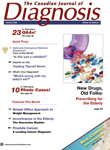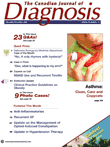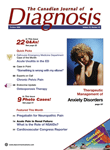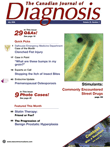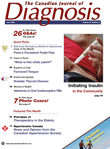The Canadian Journal of Diagnosis
2008 Back-Issues
2001 • 2002 • 2003 • 2004 • 2005 • 2006 • 2007 • 2008 • 2009 • 2010 • 2011 • 2012
Jan • Feb • Mar • Apr • May • June • July • Aug • Sept • Oct • Nov/Dec
|
November/December 2008, Volume 25, Number 11
Dalhousie Emergency Medicine Department
Case of the Month
"No, it only rhymes with hysteria"
Case in Point
"Doc, what is happening to my arm?"
Experts on Call
Answers to your questions from our medical experts
• Treating Relapsing C.Difficile
• Treatment of Diabetes in Older Children
• Indications for Combining Clopidogrel and Warfarin
• Eczema in Dark-Skinned Children
• Use of Buprpion in Pregnancy
• Colon Cancer Screening Programs
• Risks of Tegaserod
• The Best Treatment for Tremor
• Lasers in Cosmetic Spas vs. Physician's Offices
• NSAID Use and Recurrent Tinnitis
• The Role of ACE Inhibitors in Renal Failure
• Screening in Hodgkin's Survivors
• Subarachnoid Hemorrhage Headache
• Depression vs. Demoralization
• Cancer Risk for Ex-Smokers
• Duct Tape in Wart Treatment
• The Best Treatment for Tinea Versicolor
• Neonatal Complications for Mothers with Lupus
• Fasting Before a Serum Lipid Profile
• Safety of the New COX-2 Inhibitors
• Using Paroxetine for Premature Ejaculation
• Frequency of Bloodwork in an Epileptic Patient
• Adding Fibrate to a Statin
What's Your Diagnosis?
Ivan's Itchy Bumps
Endocrine Update
Clinical Practice Guidelines on Obesity
Photo Diagnosis
Illustrated cases with questions to test your diagnostic skills
• Peter's Pruritic Plaques
• Lee's Lower Lip
• Norah's Nipple
• Francine's Foot
• Natalie's Knee
• Ian's Itchy Papules
• Barry's Bothersome Back
• Frank's Forehead
• Chung's Cheek
Asthma: Clues, Care and Copycats
M. Diane Lougheed, MD, MSc, FRCPC
Asthma is a common chronic inflammatory disorder of the airways, which affects > 300 million individuals worldwide of all ages and all ethnic backgrounds. Over 10% of Canadian adults report current asthma symptoms, which is the fifth highest prevalence in the world. Asthma can be challenging to diagnose in adults. Dr. Lougheed reviews the signs and symptoms that can help in the diagnosis and treatment of asthma.
Anti-Inflammatories: Making an Informed Decision
Marcelo C. Shibata, MD
Chronic inflammatory disease affects a significant part of the North American population and is the
number one cause of disabilities. Specific COX-2 inhibitors were developed to provide significant
anti-inflammatory activity without deleterious GI-side effects. in this article, Dr. Shibata presents a
summary of the available evidence of the use of COX-2 inhibitors.
Recurrent AF: Choosing the Right Drug
John L. Sapp, MD, FRCPC; and Andrew Liu, MBBS, FRACP
Atrial fibrillation (AF) is the most common sustained cardiac arrhythmia, affecting an estimated 2.3 million people in North America. AF is associated with an increased risk of stroke and all-cause mortality. Here, Dr. Sapp provides guidance as to what drug to prescribe for your patients.
What's New in Clinical Research
Erica L. Weinberg, BSc, MSc, MPhil, MD
Update on the Management of Opioid-Induced Constipation.
Non-Calcium Renal Stones: Diagnosis and Prophylaxis
Joel M. H. Teichman, MD, FRCSC
Urinary stone prevalence is estimated at 3%, affects up to 12% of the population and recurrence rates approach 55%. Renal deterioration is more likely from recurrent compared to solitary stone episodes.
In this article, Dr. Teichman discusses the evaluation and management of metabolic stone disease and uric acid, struvite and cystine stones.
What's New in Clinical Research
Peter J. Lin, MD, CCFP
Update in Hypertension Therapy
|
|
|
|
October 2008, Volume 25, Number 10
Dalhousie Emergency Medicine Department
Case of the Month
"Acute Uvulitis in the ED"
Case in Point
"Something is wrong with my elbow!"
Experts on Call
Answers to your questions from our medical experts
• Treatment for Post-Nasal Drip
• Antibiotics for Pregnant Women
• Methotrimeprazine as a Sleeping Pill
• Ciclopirox and Onychomycosis
• Treatment of Diabetes in Older Children
• Screening Men for Osteoporosis
• Choosing a Statin for Hypercholesterolemia
• What Age to Start Mammograms
• Causes of Bronchitis
• Lipodermatosclerosis in Venous Stasis Disease
• Desensitizing Allergic Individuals
• Gouty Tophi on a Single Finger
• B-Blockers in COPD Patients
• Chronic Pelvic Pain
• Reasonable Work-Up for Panic Disorder
• Topical Calcineurin Inhibitors
• Stress ECHO for Coronary Artery Disease
• Investigating Right Bundle Branch Block
• Diagnosing and Investigating Bell's Palsy
• Alternate Options for Osteoporosis Management
• Interventional Treatment of Cerebrovascular Disease
• Ice Cream in Lactose Intolerant Patients
What's Your Diagnosis?
"Help! My headaches keep getting worse."
Endocrine Update
Osteoporosis Therapy: When Do We Start and Stop?
Photo Diagnosis
Illustrated cases with questions to test your diagnostic skills
• Simon's Scalp
• Liam's Lower Back
• Samantha's Shoulder
• Nicholas' Neck
• Erica's Ear
• Lindsay's Leg
• Patrick's Pain
• Mark's Mole
Therapeutic Management of Anxiety Disorders
Alfred J. Remillard, Pharm.D., BCPP
Anxiety disorders are among the most prevalent of mental disorders, afflicting about 13.3% of the general population. Although chronic and debilitating, these disorders remain under-diagnosed and therefore untreated, which leads to overuse of both pyschiatric and non-psychiatric services. In this article, Dr. Remillard details the therapeutic management of these common disorders.
Pregabalin for Neuropathic Pain
Joshua Shadd, MD, CCFP
Neuropathic pain can be challenging to treat and does not respond as well as nociceptive pain to standard non-opioid and opioid analgesic medications. Adjuvant analgesics are therefore considered
first-line treatment for chronic neuropathic pain. A variety of medications have been shown to be effective in treating neuropathic pain. Dr. Shadd discusses the effects of pregabalin on neuropathic pain.
Acute Pain in Renal Failure: What is the Role of NSAIDs?
Juliette Sacks, MD, CCFP-EM
NSAIDs are very effective analgesics. They are available in OTC and prescription formulations. They are used to treat renal colic with good effect. However, what is their safety in the setting of a patient with mild renal impairment? Dr. Sacks provides the answer to that question within this review.
Cardiovascular Congress Reporter
Optimal Risk Reduction in Diffuse Vascular Disease: Focus on Peripheral Arterial Disease.
|
|
|
|
September 2008, Volume 25, Number 9
Dalhousie Emergency Medicine Department
Case of the Month
"A bus just went off the road!"
Case in Point
"What's on my stomach?"
Experts on Call
Answers to your questions from our medical experts
• Approaching a Patient with an Alcohol Problem
• Commonality of Brugada Syndrome
• Toxoplasmosis Screening During Pregnancy
• Targeted Oncolytic Viruses
• Office-Based Therapies for Genital Warts
• Warfarin and Pulmonary Hypertension
• Swimming During Treatment of Otitis Externa
• Asymptomatic Elevation of Creatine Kinase
• Benign Positional Vertigo
• H. Pylori and Gastric Cancer
• Treatment of Tinea Versicolor
• Estimated Glomerular Filtration Rate
• Pickwickian Syndrome
• Stem Cell Transplant and Hodgkin's Lymphoma
• Treatment of Type 2 Diabetes
• Imiquimod Treatment for Warts
• Treating Low HDL-C
• X-Rays in Low Back Pain
• Differences in the Treatment of Otitis Media
• Prescribing an Adrenaline Auto Injector
• Health Concerns with Bromine Use
• Investigating a First Episode of Kidney Stones
• Causes of Hair Loss in Teenagers
• Role of Serum Catechol in Depression
What's Your Diagnosis?
"Doc! I have a strange pain in my right shoulder."
Endocrine Update
Management of Thyroid Disease in Pregnancy
Photo Diagnosis
Illustrated cases with questions to test your diagnostic skills
• Nelly's Nose
• Parker's Plaques
• Bill's Blue Bump
• Sara's Stomach
• Harold's Hand
• Roger's Itchy Rash
• Barry's Back
• Gilbert's Gums
Chronic Kidney Disease: Optimal and Coordinated Management
Michael Copland, MD, FRCPC
Chronic kidney disease is a common condition, affecting approximately 1.9 million Canadians. It is common, severe and treatable, provided it is recognized at an early enough stage. Here, Dr. Copland brings us through the management of this serious disease.
The Red Eye: A Systematic Approach
Stephanie Baxter, MD, FRCSC
The red eye is the most common ocular condition the primary care practitioner faces. Its diagnosis can be very challenging. In this article, Dr. Baxter attempts to develop a systematic approach to the red eye, in order to enable the primary care practitioner to identify which patients they will treat themselves and which patients will be referred for further assessment and management.
Type 2 Diabetes: Pharmacological Management
Jason M. Kong, MD, FRCPC
Type 2 diabetes conceptually is a combination of genetic disposition of relative insulin deficiency and insulin resistance. The most prevalent cause of acquired insulin resistance is obesity. Dr. Kong details how to manage this prevalent condition.
Hepatitis ABC: A Review of Viral Hepatitis
Alnoor Ramji, MD, FRCPC
Chronic viral Hepatitis is a major public health issue in Canada. Both Hepatitis B virus or Hepatitis C virus result in a slowly progressive liver disease, leading to cirrhosis, decompensation or hepatocellular carcinoma. In this review, Dr. Ramji shows that, fortunately, effective therapy is now available for both Hepatitis B and Hepatitis C that should reduce the frequency of adverse outcomes.
Hypertension Canada
Should We Treat Hypertension in Patients 80 Years of Age and Older?
Results from the HYVET Trial
|
|
|
|

|
August 2008, Volume 25, Number 8
Dalhousie Emergency Medicine Department
Case of the Month
"Do you think it's a stroke, Doc?"
Case in Point
"What's this mark on my eyelid?"
Experts on Call
Answers to your questions from our medical experts
• Ruling Out Lactose Intolerance
• When to Use Rosiglitazone
• Safety of PPIs in Pregnancy
• Accuracy of Allergy Testing
• Carcinogenic Risks of CT Scans
• Prednisone and Shingles
• Freezing Cherry Angiomas
• Dealing with High BP at Work
• Treating a Flu Outbreak in a Nursing Home
• Causes of Post-Nasal Drip
• Limits to Length of Botox® Use
• Medical Marijuana and Bipolar Disorder
• Best Delivery Mode for Breech Twin Presentation
• Limiting “Off” Periods of Levodopa
• Using Vitamin D Weekly
• Measuring Alcohol Intake
• Liquid Treatment of Finger Infections
• When to Discontinue Statin Therapy
• Routine Follow-Ups in Childhood Cancer Survivors
Endocrine Update
New Therapies for the Treatment of "Diabesity"
Photo Diagnosis
Illustrated cases with questions to test your diagnostic skills
• Rhiannon’s Ring Finger
• Liam’s Linear Eruption
• Martha’s Mass
• Peter’s Painful Papules
• Lukas’ Legs
• Ron’s Recurrent Rash
• Shawn’s Shoulder
COPD Exacerbations: Managing a Frequent Problem
C. M. Parker, MD, MSc, FRCPC, FCCP
Acute exacerbations of chronic obstructive pulmonary disease (AECOPD) are the most frequent causes of medical visits, hospitalization and death among patients with COPD. Dr. Parker details how a physician can help to diagnose, prevent and treat this often underreported condition.
DerMANtology 101: Common Skin Problems Seen in Men
Tiffany Kwok, BHSc; and Jaggi Rao, MD, FRCPC
There are many skin and hair issues for which men will commonly consult their physician. To test your knowledge, Ms. Kwok and Dr. Rao present some cases spanning common dermatological conditions with male predilection.
|
|
|
|
July 2008, Volume 25, Number 7
Dalhousie Emergency Medicine Department
Case of the Month
Clenched Fist Injury
Case in Point
"What are these bumps in my groin?"
Experts on Call
Answers to your questions from our medical experts
• Rising Creatine Phosphokinase on Fenofibrate
• Endoscopic vs. Open Removal of the Prostate
• Management Options for Gout
• Seeds and Nuts and Diverticulitis
• Recommended Antihypertensive for Aortic Insuffiency
• Significance of Sputum Colour
• Stopping the Itch of Insect Bites
• ARBs for Isolated Hypertension
• Treatment of Peripheral Vertigo
• Best Antidepressant During Pregnancy
• CT vs. MRI for Putiutary Adenoma
• Efficacy for Imiquimod for Plantar Warts
• Safety of Flu Shots in Infants
• Commonality of Asymptomatic Pelvic Vein Thrombosis
• HPV Vaccine in Boys
• Replacing an ACE Inhibitor with an ARB
• Diagnosing Diabetes in the Pediatric Population
• Length and Dose of PPI Treatment for Reflux
• The Success of the Obturator Tape Procedure
• Chronic Inflammatory Demyelinating Polyneuropathy
• Treating Osteoporosis in Patients with Renal Failure
• Investigating Angioedema During Pregnancy
• Treating Psychogenic Pruritis
• Chelation Therapy
• Managing Acutely Increasing Creatinine
• Urologic Work-Up for Enuresis in a Child
• Reducing Scarring After Surgery
• Lotions to Lighten Brown Spots
• Medroxyprogesterone Acetate and BMD
Endocrine Update
Premenopausal Osteoporosis
Photo Diagnosis
Illustrated cases with questions to test your diagnostic skills
• Paula's Papules
• Travis' Thumbnails
• Estelle's Eye
• Parker's Plaques
• Beth's Bruises
• Lucie's Lines
• Fiona's Fingers
• Emma's Ear
• Aaron's Abdomen
Stimulants: Commonly Encountered Street Drugs
Constance Leblanc, CCFP(EM), FCFP, MAE; and Nancy Murphy, CCFP(EM), ABFM, ABMT
Stimulants are readily available as street and prescription drugs. In this review, Dr. Leblanc and Dr. Murphy detail the importance of recognizing the sympathomimetic toxidrome, managing the associated symptoms and providing appropriate supportive care.
Statin Therapy: Friend or Foe?
Kiranbir Josan, BSc, MD; and Gabor Gyenes, MD, PhD
Although registry data suggest that primary care physicians are knowledgeable about current lipid targets, one-half of the patients are not meeting recommended lipid targets. This may be attributed to fear of side-effects. especially at higher doses and to compliance issues. In this article, Dr. Josan and Dr. Gyenes review the evidence behind the risks associated with statin therapy.
The Progression of Benign Prostatic Hyperplasia
Theresa J. McCallum, MD, FRCSC
Benign prostatic hyperplasia (BPH) is a non-cancerous enlargement of the prostate caused by the growth of new cells. It results in varying degrees of bladder outlet obstruction. Dr. McCallum reviews BPH from etiology, to diagnosis, treatment and referral. |
|
|
|
June 2008: Volume 25, Number 6
Dalhousie Department of Emergency Medicine
Case of the Month
Peter's Persistent Pedal Pain
Case in Point
"What is this white patch?"
Experts on Call
Answers to your questions from our medical experts
• Cancer of the Tongue and HPV
• Elevated Glomerular Filtration Rate in an Elderly Patient
• Management of Lichen Planus
• Intolerance of Statins
• Recommendations Post Prostate Biopsy
• The Value of Random Serum Cortisol
• Heart Attacks in a Car
• Contracting Tularemia from Skunk Feces Dust
• Soy Products and Breast Cancer
• Psoriatic vs. Rheumatiod Arthritis
• Furrowed Tongue
• Dangers of Ear Candling
• New Neuroleptics for Psychoses
• HPV and Squamous Cell Carcinoma
• Outgrowing Asthma
• OC Use During Lactation
• False-Positive Mono Tests
• Melanoma in Sunburnt Skin
• Appropriate Cancer Screening Tests
• Investigating Angioedema During Pregnancy
• Irritable Bowel Syndrome and Crohn's Disease
• Omega-3 Supplements for Pregnancy and Breastfeeding
• Assessing Changes in Bone Density
• Managing Acutely Increasing Creatinine
• Common Causes of Loss of Smell
• Venous Thromboembolism in Pregnancy
Endocrine Update
Nodular Thyroid Disease: Who Do We Biopsy?
Photo Diagnosis
Illustrated Cases with questions to test your diagnostic skills
• Nathan's Nose
• Sally's Spots
• Eric's Eruptions
• Pamela's Papules
• Henry's Hand
• Renata's Rough Patches
• Hillary's Hemangioma
Women's Health
Advances in Oral Contraceptive Pills
Although there are many options in OCPs today, there is a lack of clinical evidence to help guide the clinician in selecting an appropriate option for their patient. Here, Dr. Motan details the advantages and disadvantages of today's OCPs.
Inititating Insulin in the Community
Karen McDermaid, BSc, BSP, ACPR, CDE
With the shortage of endocrinologists and the growing number of individuals with diabetes, it is imperative that primary care providers be able to initiate insulin in their clients. This article outlines the targets and treatments for patients with diabetes.
Principles of Therapeutics in the Elderly
Katherine Lechelt, MD, FRCPC
Individuals > 65-years-of-age consume approximately 40% of prescription drugs, despite the fact they represent only 13% of the total Canadian population. It is estimated that the prevalence of potentially inappropriate prescribing in this age group ranges from 12% to 40%. In this review, Dr. Lechelt provides guidance on how to appropriately prescribe for your elderly patients.
What's New in Clinical Research
Andre Roussin, MD, FRCP and Richard Harvey, MD, FRCP, FACC
Update on the Reimbursement Coding for Clopidogrel in Quebec–RAMQ Formulary.
|
|
| |
|

|
May 2008: Volume 25, Number 5
Dalhousie Department of Emergency Medicine
Case of the Month
“Have I lost my mind?”
Case in Point
“What are these white patches?”
Experts on Call
Answers to your questions from our medical experts
• Giant Cell Tumours and Osteosarcoma
• Black Hairy Tongue
• Topical vs. Oral NSAIDs
• Cough due to Bordetella Pertussis
• Developing Gynecomastia
• Hypnosis as a Medical Therapeutic Agent
• Treating Bacterial Vaginosis in Early Pregnancy
• Taking Patients Off BP Medication
• Immunizing Patients Who Have Splenectomies
• Risk of Developing Colorectal Cancer
• Meniere’s Disease
• Lactobactillus in a Urine Culture
• Right Bundle Branch Block
• Commonality of True ASA Allergy
• Pityriasis Alba vs. Rosacea
• Ordering PSA
• Persistent, Foul Vaginal Odour
• Screening for Bladder Cancer
• Calcium Supplementation Options
• Using Insulin Glargine in an Adolescent
• Allergies to Antihypertensive Medication
• Naltrexone for Alcoholic Patients
• Skin Changes With Topical Steroid Use
• ß-Blockers in Chronic Obstructive Lung Diseases
• Significance of Adenomyosis in Pelvic Ultrasound
• Considering Surgery for Stress Incontinence
• Treating Keratosis Pilaris
• Renal Effects of Lithium
• Working-Up Urinary Tract Infections in Males
Endocrine Update
Type 1 Diabetes in Pediatrics
Photo Diagnosis
Illustrated cases with questions to test your diagnostic skills
• Nazaneen’s Nodule
• Lucio’s Scrotal Lump
• Chris’ Cough
• Paul’s Pimples
• Foster’s Foot Abnormality
• Parson’s Purple Papules
• Shelton’s Shortness of Breath
• Lawford’s Lesion
Women’s Health
IUDs and Endometrial Biopsy
Sally Mahood, MD, CCFP, FCFP
IUDs are low maintenance, inexpensive, reversible and underutilized in Canada. They are used by 13% of women worldwide, but by only 1.5% of women 15- to 45-years-of-age in Canada.
Pancreatic Cancer:
The Role of Endoscopic Ultrasound
Jennifer A. Flemming, MD; and Lawrence C. Hookey, MD, FRCPC
Pancreatic cancer is the eleventh most common malignancy in Canada but is the sixth leading cause of cancer death with 3,500 people receiving the diagnosis and 3,400 patients succumbing to the disease in 2006.
Chronic Shoulder Pain: From A to Z
Peter Lapner, MD, FRCSC
Chronic shoulder pain is a term that refers to pain that occurs for a duration longer than four to six months.
End-Stage Cirrhosis: Complications, Diagnosis and Management
Urs P. Steinbrecher, MD, FRCPC
In early stages, cirrhosis may not cause any symptoms and may be associated with few, if any, physical findings
Top 10 Prescribed Drugs: Important Interactions
Karen A. Jensen, MSc, BSP
With more drugs and drug combinations being used than ever before, the potential for adverse effects due to interaction is also increasing. The actual incidence of clinically significant interaction has not been determined but it is known to be a factor in many ER visits and hospital admissions.
Dyslipidemia: When the Usual Statins Are Not Enough
David Blank, MDCM, FRCPC (Medical Biochemistry)
Coronary artery disease (CAD) is a major cause of morbidity and mortality in Canadians. Hypercholesterolemia, a major risk factor for CAD, requires aggressive treatment. Five classes of medications are used in the treatment of dyslipidemia.
Clinical Viewpoint
Brian Goldman, MD, MCFP (EM), FACP; and Alan Kaplan, MD, CCFP (EM)
Assessment and Management of Chronic Pain and the Potential Role of Narrative Medicine
What's New in Clinical Research
Pratap R. Chokka, MD
Clinical and Functional Benefits of Escitalopram for the Treatment of Major Depressive Disorder in Primary Care: A Canadian Naturalistic Investigation in Depression (NAVIGADE).
|
|
| |
|
|
April 2008: Volume 25, Number 4
Dalhousie Department of Emergency Medicine
Case of the Month
“Is it broken?”
Case in Point
“What are these white patches?”
Experts on Call
Answers to your questions from our medical experts
• Whispering During Laryngitis
• Schizophrenia and Diabetes
• Understanding Halitosis
• Do Antidepressants Cause Vivid Dreams?
• Decreasing Microalbuminuria Levels
• ß-Blockers for Heart Failure
• Hair Dye Use During Pregnancy
• High Folic Acid Intake and Bowel Cancer
• Prevalence of Lyme Disease in Canada
• Following-Up on Mildly Elevated PSA
• Treating Cradle Cap
• Lubricating Gel and Pap Smears
• Is Strontium Better than a Bisphosphonate?
• Using Statins in Adolescents
• Can Traumatic Experiences be Erased from Memory?
• Risk of Prednisone Use for Poison Ivy
• Are Flu Shots During Pregnancy Safe?
• Evaluating Elevated Creatinine
• Looking at Multiple Endocrine Neoplasia
• Penile Engorgement: A Normal Physiologic Reaction?
• Drugs to Relieve Fibromyalgia Pain
• Canadian Data on Anaphylaxis
• Diagnosing the Metabolic Syndrome
• Routine Specimen Collection for STIs
• The Danger of Portable Media Players
• Antibiotics and OC Efficacy
• Roll of Caffeine in Hypertension
• Benefit of Humidified Air in Croup
• Belching in Adults
• Consequences of Asbestos Exposure
What's Your Diagnosis?
"What’s wrong with my son’s lip?"
Endocrine Update
Renal Osteodystrophye
Photo Diagnosis
Illustrated cases with questions to test your diagnostic skills
• Thane’s Thinning Hair
• Patrick’s Pain
• Lester’s Lesions
• Finn’s Facial Sore
• Ramona’s Rash
• Doris’ Deformity
• Song’s Gray Spots
• Sergio’s Scalp
Women’s Health
New Options in Contraception
Fiona Mattatall, MSc, MD, FRCSC
The ideal contraceptive should be inexpensive, easy to use, readily available and safe. Since the Canadian legalization of the OC pill in 1969, a number of improvements and contraceptive alternatives have been introduced. This article will review current contraceptive options and future prospects.
Managing Eating Disorders: The Refeeding Syndrome
Laird Birmingham, MD, BSc, MHSc, FRCPC, FACP, ABIM, FAED
The refeeding syndrome is the set of complications that occur during refeeding in a patient with an eating disorder. GPs must take care to monitor and prevent this syndrome.
Erectile Dysfunction: An Old Question with New Answers
Michael B. Greenspan, MD, FRCSC; and Anthony J. Bella, MD, FRCSC
Even though population and demographic studies suggest that erectile dysfunction (ED) is present in at least 30% to 40% of the population (and the incidence is increasing with age), it appears that < 20% of the “target population” is being treated. Why do patients who suffer from ED not know more about their treatment options? Read on to learn the answer to this question and more.
Painful Bladder Syndrome: A Chronic Condition
Joel M. H. Teichman, MD, FRCSC
Interstitial cystitis/painful bladder syndrome (IC/PBS) is a chronic bladder condition that is prevalent, representing 3% of diagnoses by Canadian urologists. However, it is underdiagnosed. Although there is no currently accepted “gold standard” of diagnosis, research advances have yielded new understanding and management options.
2008 CHEP Recommendations: An Annual Update
On behalf of the Canadian Hypertension Education Program (CHEP)
The year 2008 marks the ninth consecutive year that the CHEP has updated recommendations for the management of hypertension. This year, CHEP focused on the healthcare professional’s role in encouraging appropriate patients to measure their BP at home properly. |
|
| |
|
|
March 2008: Volume 25, Number 3
Dalhousie Department of Emergency Medicine
Case of the Month
“Is this simply a headache?”
Case in Point
“What are these purple marks?”
Experts on Call
Answers to your questions from our medical experts
• Itch Caused by Dry Canadian Winters
• Can PPIs Cause Leg Cramps?
• What to do About Fecal Incontinence
• Do Cortisol Levels Affect Mood and Mental Status?
• Treating Residual Ovarian Syndrome
• Canadian Calcium and Vitamin D Guidelines
• ECGs Suggesting a MI
• Appropriate Length of Time for Dialysis Treatment
• The Role of a Doula
• Vaginal Estrogen: An Interference?
• Dealing with Elevated Thyroxine in a Young Female
• The Appearance of Giant Urticaria
• Risk of Deep Vein Thrombosis After Surgery
• Burning in the Glans Penis
• Is There a Correlation Between Post-Menopausal Bleeding and Myomas?
• Post-Infectious Cough
• Switching a Diabetic to Insulin
• Altered Taste Sensation and Chemotherapy
• Candidate for Second-Line Osteoporosis Therapy
• Investigation/Treatment for Hair Loss
• Triptans for Migraines
• Use of Cytobrush in Early Pregnancy
• Beneficial Exercise Levels for HDL-C
• Treating Warts in the Urethral Meatus
• How Often to Screen with a 24-Hour Urine Protein?
What's Your Diagnosis?
"Doctor, please help! I'm so tired of the pain."
Endocrine Update
The Isolated Thyroid Nodule
Photo Diagnosis
Illustrated cases with questions to test your diagnostic skills
• Fred’s Forehead
• Marvin’s Mass
• Barney’s Brown Lesions
• Shane’s Scrotal Swelling
• Shawn’s Spots
• Wanda’s Wound
• Terry’s Toe
• Miguela’s Mouth
• Ralph’s Rash
• Heather’s Headaches
Women’s Health
Diagnosing Venous Thromboembolism in Pregnancy
David X. Sam, MD, FRCPC
Venous thromboembolism (VTE), which includes deep vein thrombosis and pulmonary embolism, is one of the leading causes of maternal mortality. However, the diagnosis of VTE in pregnancy can often be challenging and requires a high index of suspicion.
Red Flags in Back Pain
Scott Paquette, MD, FRCSC
The lifetime prevalence of low back pain is reported as > 70% in industrialized countries (one-year prevalence is 15% to 45%; adult incidence is 5% per year). The majority of these patients will improve on their own; however, a small portion will harbour more serious pathology. A list of red flag symptoms is commonly used to help identify this group.
Testosterone and Growth Hormone: Use and Misuse in Sports
Donald W. Morrish, MD, PhD, FRCPC
Testosterone and growth hormone use in sports remains widespread and shows no evidence of abating. Testosterone has definite dose-related effects on strength and muscle size though it comes with some cost in side-effects.
Antidepressant Therapy: Making the Appropriate Choice
Alfred J. Rémillard, PharmD, BCPP
The World Health Organization predicts that by the year 2020, the prevalence of major depressive disorder (MDD) will be second to ischemic heart disease. The lifetime prevalence for MDD is 8%. In this article, Dr. Rémillard examines antidepressant therapy and the steps to follow in order to successfully treat a depressed patient.
Common Fungal Infections of The Nail
Afsaneh Alavi, MD; Kevin Y. Woo, MSc, RN, ACNP, GNC(C); and
R. Gary Sibbald, BSc, FRCPC (Med) (Derm), FAPWCA, Med
Although onychomycosis is the most common nail disorder, it is only one of the numerous causes of abnormal nails. The prevalence of onychomycosis in the Canadian population was previously estimated to be 6.5%. However, a Canadian study of 15,000 patients identified that 16.7% of respondents had abnormal nails with 8% demonstrating mycological evidence of onychomycosis. Follow along for a look at different fungal infections of the nail. |
|
| |
|

|
February 2008: Volume 25, Number 2
Dalhousie Department of Emergency Medicine
Case of the Month
“Is this just a cellulitis?”
Case in Point
“What are these pimples?”
Experts on Call
Answers to your questions from our medical experts
• “The” Blood Test for Testicular Carcinoma
• Depot Medroxyprogesterone Acetate and Osteoporosis
• Looking at Dyspepsia
• Is the Metabolic Syndrome a Form of Cushing Disease?
• Operating for Aortic Stenosis
• Investigating Creatinine Levels in the Elderly
• Referral for Genetic Testing for the Breast Cancer Gene
• Transcranial Magnetic Stimulation Therapy
• Taking Glucosamine Post Hip Replacement Surgery
• Treating Thyroid Storm
• Homocysteine as a Cardiovascular Risk Factor
• Relationship Between Anorexia, Growth Hormone and Somatostatin
• Biologic Agents in Psoriatic Arthritis
• Investigating Chronic, Dry Cough
• The Effect of Right Bundle Branch Block in an Athlete
• Work-Up for an Extended Period of Amenorrhea
• GI Reactions to Food Allergies
• Working-Up Symptomatic Hematuria
• Should ASA be Discontinued Before an Operation?
• Nutmeg Allergy
• Peak Season for Asthma
• Alternative Contraceptives
• Starting Dialysis in Renal Insufficiency
What's Your Diagnosis?
"What's wrong with my baby's ear?"
Endocrine Update
Insulin Therapy: When, Which, How?
Photo Diagnosis
Illustrated cases with questions to test your diagnostic skills
• Mary’s Marks
• Lewis’ Lesions
• Robert’s Rash
• Patty’s Itchy Patch
• Bryanne’s Bullae
• Logan’s Lumbar Pain
• Diana’s Discharge
• Radley’s Red Patches
• Sheila’s Dark Skin
• Helen’s Hair Loss
New Drugs, Old Folks: Prescribing for the Elderly
Allen R. Huang, MDCM, FRCPC
Prescribing medications for the elderly becomes more challenging each year as new drugs are approved for use in Canada. This article will describe some of these new drugs and their appropriate use in elderly patients.
Simple Office Approach to Weight Management
Catherine McKenna, MSc, MD, CCFP
Obesity is a complex, chronic disease whose etiology is still not fully understood and physicians must take care to help obese patients as they face greater health risks. In this review, Dr. McKenna provides readers with an interventional approach to helping overweight patients.
Incontinence in the Elderly: The Overactive Bladder
Leo Winter, MD, FRCSC
Incontinence in the elderly is a common problem. Estimates of its prevalence range between 15% and 30% for both men and women > 65-years-of-age. Avoiding factors which aggravate the symptoms of bladder overactivity is the mainstay of maintaining continence in this population.
Prostate Cancer: A Leading Cancer Diagnosis
Bobby Shayegan, MD, FRCSC
Prostate cancer is among the leading causes of illness and death in Canada and in the US. Among men, it is the leading cancer diagnosis and the third most common cause of cancer-related mortality. Follow along as Dr. Shayegan reviews this disease, from screening methods to treatment options.
|
|
| |
|
January 2008: Volume 25, Number 1
Dalhousie Department of Emergency Medicine
Case of the Month
“I think I caught the stomach flu”
Case in Point
“Why am I losing my hair?”
Experts on Call
Answers to your questions from our medical experts
• Risks/Benefits of Menstrual Suppression
• The Hallmark Rash of Celiac Disease
• Working-Up Asymptomatic Hematuria
• A Quick Look at the Mini-Mental State Exam
• Following-Up on Height Loss in Osteoporosis
• How Can a Stem Cell Transplant Improve Multiple Myeloma?
• Hypertension Treatment Threshold for the Elderly
• Is There a Correlation Between Thyroid Disease and Fatty Liver?
• Progression to the Development of Mesothelioma
• Best Treatment for Premenopausal Osteoporosis
• A Look at Montelukast
• Hepatic Cysts
• Beginning Mammogram Screening
• Dealing With Chronic Recurrent Yeast Infections
• Calcium Supplements for Hypoparathyroidism Patients
• Stopping Warfarin Before Dental Surgery
• Citalopram vs. Escitalopram
• Treating Tenosynovitis
• Is it Necessary to Follow-Up with an Oncologist?
• How High is Too High for Creatinine?
What's Your Diagnosis?
"Doc, why do I weigh so much?"
Endocrine Update
Antiresorptives: What’s New?
Photo Diagnosis
Illustrated cases with questions to test your diagnostic skills
• Ned’s Nodule
• Uma’s Umbilicus
• Peg’s Pigmentation
• Thalia’s Thickening Skin
• Alex’s Abnormal Scars
• Norman’s Knee
• Pablo’s Patch
• Maranda’s Mass
• Erin’s Eruption
• Dan’s Discoloured Marks
Women’s Health
Hormone Therapy: The Changing Landscape
Jan Christilaw, HBSc, MD, FRCSC, MHSC
The question of hormone replacement therapy for menopausal women remains to be one of the most hotly debated questions in medicine today. Our goal should always be to balance the risks and benefits while optimizing the chance of good health throughout the life span of our patients.
Hepatitis C Virus: What Clinicians Need to Know
Saleh Alqahtani, MBChB, DABIM, FRCPC
Hepatitis C virus (HCV) represents a major public health problem in the world, infecting approximately 3% of the world’s population. Follow along to learn more about HCV diagnosis and treatment.
Kidney Stones: Options for the GP
Joel M. H. Teichman, MD, FRCSC
Urinary stone prevalence is estimated to be at 3%, affecting up to 12% of the population during their lifetime and recurrence rates approach 50%. In this article, the diagnosis and management are reviewed for renal and ureteral stones.
Chronic Heart Failure: A Quality of Life Issue
Abdulaziz Alghamdi, MD; and Haissam Haddad, MD, FRCPC, FACC
Heart failure (HF) is a complex clinical syndrome and patients have a poor prognosis, with an average one-year mortality of 33%. In Canada, the incidence of hospitalization due to HF is estimated to increase three-fold over the next 30 years. In this article, Dr. Alghamdi and Dr. Haddad review this syndrome and provide options for its management.
|
|


